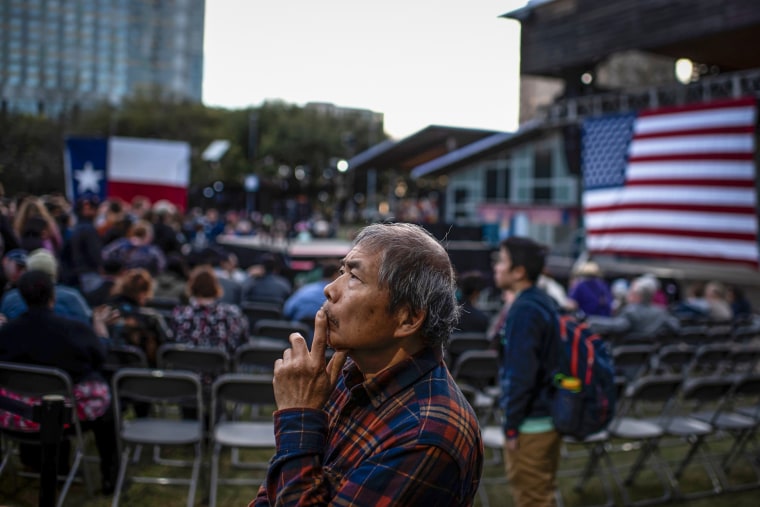Parties and candidates should be doing more to align with Asian Americans and Pacific Islanders' interests in Texas, who are growing rapidly and are eager to vote in the midterm elections, a new report indicates.
Sixty-four percent of the state’s Asian American and Pacific Islander electorate is “highly motivated” to vote in the midterm elections, the civil rights nonprofit group Asian Texans for Justice said in a new poll. Researchers say it’s critical for parties and candidates to take tangible steps to better understand the electorate.
The racial group, the report revealed, is the fastest-growing voter population compared to all other races in the state.
“This is a community that is sort of up for grabs to bring in and to make sure that you’re listening to these communities and so that you’re shaping policy and messaging in your campaigns to serve them,” said Ashley Cheng, the organization’s founding president. “But it feels like a missed opportunity. … We need to be listened to.”
Researchers surveyed 2,700 likely voters in Texas, including 660 Asian Americans, in July. Participants were surveyed online and in English. The results showed 42% of Asian Americans and Pacific Islanders identify as Democratic and 29% as Republican. About one-third identify as independent.
The research also finds a large gender divide, with 49% of Asian American and Pacific Islander women identifying as Democrats, nearly twice the proportion of men. Asian American and Pacific Islander men are more likely to identify as Republicans, at 38%, or independents, at 35%. Cheng said that could have to do with representation in Texas politics.
“If you’re looking across party lines, that is the difference you just can’t dispute — that there are more likely current elected leaders, political candidates who are women on the Democratic side than on the Republican side,” Cheng said, adding that insufficient representation is an issue Asian American women have reported to be of critical importance.
As for key issues, 98% of participants see economic recovery as a priority. They also reported inflation, education and voting rights as critically important. In terms of their policy opinions, Asian American and Pacific Islander voters skew liberal, the report found, with Republicans in the group also leaning left of Republicans statewide.
Roughly 83% of Asian American and Pacific Islander voters said they support gun safety reform, and more than three-quarters believe abortion should be legal in most or all cases. Fifty-four percent oppose banning teaching critical race theory. The majority of respondents supported expanding the teaching of ethnic studies, including two-thirds of Republicans in the group.
As motivated as the group appears to be for the midterms, much of that is likely to reflect their dissatisfaction with officials, the report says. Only 20% of respondents say Asian American and Pacific Islander interests are “well represented in government.”
Campaigns, while having ramped up efforts in recent years, have not sufficiently reached out to the racial group, either. A survey from nonprofit research organization AAPI Data shows that 52% of Asian Americans nationwide had had no contact from the Democratic Party, and 60% had had no contact from Republicans. Cheng said that Asian American youths in particular, who make up a disproportionately large part of the racial group, are not being heard.
Karthick Ramakrishnan, the founder of AAPI Data, said that while the data is largely consistent with other research on Asian American voters in Texas, there are still some limitations. Because the survey was conducted in English, participants could have been skewed more toward being U.S.-born and produced results that tilted toward the Democratic Party. Data on the electorate from the Pew Research Center shows that the majority are foreign-born naturalized citizens.
Ramakrishnan also said that while the number of Asian American and Pacific Islander voters is surging, they make up a relatively small proportion of voters, at 4.6% of the electorate. And in terms of communities of color, he said, Latino voters have amassed significant power across the state, where they cast about 20% to 25% of all votes. But elections across Texas have been getting tighter, and that’s where Asian Americans come in.
“One needs to be realistic, because you have a much larger Latino electorate who, at least in certain parts of Texas and especially in southern Texas, seems to be trending more towards the Republican Party,” he said. “Parties, especially the Democratic Party in Texas, as well as Democratic candidates, may be looking to outreach to Asian Americans to offset some of that.”
Outreach matters, Ramakrishnan said. The report found that Asian American voters in Texas are more likely to be immigrants compared to all other races. Ramakrishnan said that contributes to a lack of strong party identification, making “the potential for persuasion greater among Asian Americans than for other groups.”
“They didn’t grow up in a Democratic or Republican household, nor did they go to a college where the parties had any kind of meaningful role in their political socialization,” he said. “They come to the U.S. without much in the way of not only party loyalties, but even knowledge about the parties. A similar dynamic applies for people who are the children of immigrants, because they’re less likely to grow up in households where politics is discussed at the kitchen table.”
The Asian American electorate will inevitably become a critical voting bloc, Ramakrishnan said. The report said that over the past decade, the Asian American and Pacific Islander populations grew by about two-thirds, accounting for 18% of the state’s overall population growth.
“We know from the political science literature that investing in outreach and education to a fast-growing population pays dividends,” Ramakrishnan said. “You’re more likely to earn the support, and ultimately the loyalty, of an electorate if you do outreach early and often.”
